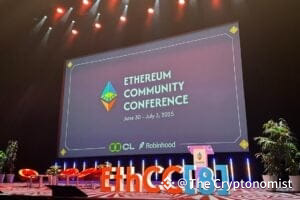
The Ethereum ecosystem has matured. That much was clear at EthCC in Cannes this year. What used to be a developer-first conference in Paris transformed into a sprawling mix of rooftop receptions, beachside salons, and yacht-side networking.
Organizers deliberately moved to Cannes to signal something bigger: Ethereum is no longer an experimental toolset. It’s a visible infrastructure. And it now has the attention of institutions, regulators, and consumer brands.

Crypto adoption needs more than vibes
When EthCC was first announced to be at Cannes, it raised some eyebrows – for good reasons. Cannes is known for luxury. Between late-night yacht parties and champagne networking, some attendees wondered whether the ecosystem was drifting too far from its roots.
Yet beneath the opulence, something real was happening. Developers still walked the streets of Cannes in startup-branded T-shirts. Technical workshops, side events, and working sessions happened across the city. Builders talked architecture, privacy layers, stablecoin rails, and incentive systems.
The shift in atmosphere wasn’t about glamor for its own sake. It was a reflection of where the crypto industry stands today: no longer fringe, but not fully institutional either. The space is still testing its identity.
It would be a mistake to dismiss the setting as frivolous. The proximity of venues, the walkable layout, and the ability to host deep-dive side events in more relaxed settings actually improved knowledge sharing. What the event did highlight, however, was the industry’s growing challenge of accessibility.
Web3 has long talked about inclusion, but as conferences evolve into exclusive environments, the risk of alienating early contributors or would-be newcomers becomes real.
“I wouldn’t read too much into Cannes as a mark on Ethereum, other than to say that Ethereum still holds incredible pull as a global ecosystem that can get the best and brightest to travel to every corner of the Earth. Cannes is hardly a difficult sell, but the ability to draw a crowd in so many different locations (both exotic and mundane) speaks to how critical of an ecosystem ETH still represents,”
said Colin Goltra, CEO of Morph.
Ethereum’s role is shifting
This year, most of the excitement centered around what’s built on top of Ethereum: Layer 2s, app chains, decentralized infrastructure layers, and cross-chain liquidity routes. Ethereum’s reliability makes it the staging ground for innovation. It’s the default. That’s not glamorous, but it is powerful.
Speakers acknowledged this shift. Shawn O’Donaghue of Orbs noted that while Ethereum is no longer the most exciting thing in the stack, it remains the layer people trust to always be there.
Other industry leaders noted the global consistency Ethereum offers. Whether the event is held in Paris, Brussels, or Cannes, Ethereum continues to attract global builders, thinkers, and regulators. That cohesion signals maturity.
It also reflects the protocol’s growing responsibility to support innovation, governance, coordination, and accessibility across borders.
Stablecoins are leading for a reason
One of the most grounded narratives at EthCC was the growing demand and adoption of stablecoins. Far from the speculative cycles of NFTs and meme coins, stablecoins were at the center of workshops, panels, and product demos.
It wasn’t surprising given that stablecoins are where regulators, users, and institutions find common ground.
Michael from Brevis pointed out that launching a stablecoin is easy. Getting people to use it is not. The harder challenge is incentivizing liquidity across decentralized finance in a trustless, scalable way. That’s where infrastructure players are now focused.
In a space often driven by narratives, they’re an anchor to real-world value. Policymakers are starting to recognize that. So are fintechs.
This shift toward utility over speculation suggests the industry is internalizing past mistakes. The loudest voices are no longer always the most influential. Builders are recalibrating toward infrastructure that holds up under scrutiny—legal, technical, and economic.
At EthCC, this became a recurring theme. Regulatory clarity in the EU and parts of Asia is creating tailwinds for projects focused on fiat-on-chain. Panels covered compliance design, CBDC integrations, and how stablecoins can serve as monetary infrastructure in emerging markets.
The focus was measured, and it was clear throughout the event that stablecoins will shape the next phase of crypto’s public legitimacy.
“The topics that everyone discusses the most are still RWA and payment tracks. Among them, due to Robinhood’s recent attempts, the on-chain gameplay of US stocks has received a lot of attention. At the same time, many investors have also begun to re-examine AI,”
said Ian Xu, Vice President at Crypto VC Foresight Ventures.
What Happens Next?
EthCC Cannes signaled that Ethereum and its ecosystem are becoming comfortable with influence. That’s a step forward. But it also means the space must decide what kind of influence it wants to wield.
Crypto doesn’t need to be underground to be meaningful. But it does need to remain open, accessible, and committed to its original principles—transparency, decentralization, composability, and user agency. If the move to Cannes helped highlight that tension, then it served its purpose.
“EthCC felt more like a cultural gathering than a conference, and that’s progress. The format opened up the space, brought in new voices, and sparked real conversations. Crypto isn’t just tech any more — it’s a creative movement. That’s how adoption happens: through connection, not just conversion,”
said Florian Klein, Lead Commercial Bitpanda Web3.
What EthCC ultimately revealed was a maturing industry in transition. The ideas are stronger. The builders are more pragmatic. The stakes are higher.
And the vibe? Still creative enough to be interesting, but matured and stable enough to be taken seriously.


